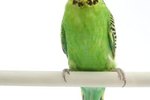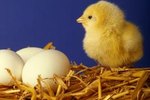Lovebirds are among the few species of animals that mate for life. Their affectionate and curious nature makes them attractive pets. They are typically low-maintenance birds, making them ideal pets for beginning bird keepers. They don’t live well alone; instead they are best kept with a partner or a larger groups of birds. Lovebirds readily mate. Determining a male lovebird from a female isn’t as easy as it is with some birds, but it's not impossible.
The Lovely Lutino
Lutino is a term for a popular color mutation among parakeets. Peach-faced or rosy-faced lovebirds are lutinos. Lutino lovebirds have a special sex-linked gene that removes dark pigments, leaving a bright red face and yellow body. Many other bird species are lutinos, most of them engineered through captive breeding.
Lovebird Types
Before you can effectively determine the gender of a lovebird -- lutino or otherwise -- it is important to know some basic facts about lovebirds in general. There are three types of lovebirds: dimorphic, intermediate, and monomorphic. Types of lovebirds that display sexual dimorphism have outwardly visible physical or color differences that make telling cocks and hens apart relatively simple. Intermediate types are more difficult to determine, as the differences occur in bone structure, not in coloration. Monomorphic types have little to no physical differences between the sexes and gender must be confirmed by DNA testing or surgical probing. Peach-faced lovebirds, like the lutino, are intermediate types and their gender can be determined just as with any other intermediate-type lovebird.
Behavioral Differences
At about 1 year of age, lovebirds may begin to display behavioral differences that give away their sex. A bird tearing up paper and stuffing it into her feathers is likely a female. This is nest-building behavior typical in many lovebird species. If, however, your bird is chewing up food and regurgitating it for you intentionally, he is likely a male. The male lovebirds feed the young, and regurgitating food for an owner is a sign of affection and bonding.
Physical Differences
Female lovebirds of the intermediate type will be slightly larger around the shoulders than their identical male counterparts. Considering that the difference can be slight, the indicator is not necessarily reliable. More reliable is pelvic bone distance. To perform this measurement, hold the bird with his back against the palm of your hand, using your thumb and little finger to hold his wings against his body. His head should protrude between your middle and ring fingers. Using a finger on your other hand, feel between the bird’s legs. You should notice two small points of bone above the tail. The pelvic span of a cock or male lovebird will be quite minimal; these bones should almost touch. A hen or female lovebird will have a much wider pelvic span. You may be able to nearly fit your little finger between these points. Do this with your birds. A bird with a larger span is likely a female.
Genetic Differences
The other option for determining the sex of your lovebird, laboratory DNA testing, is by far the most reliable. The DNA can come from eggshell, blood or feather. If your bird is a hatchling, fresh eggshell testing is easiest. For an adult bird, blood and feather testing are equally reliable. You can have a local veterinarian take a blood sample -- you need only one or two drops -- if you prefer blood over feather. Another option is to send five small chest feathers from your birds to be used for identification. If you have never plucked feathers for analysis, consult a veterinarian. A bird may twitch slightly when you pluck a feather, but doing so properly does not harm your pet. Once you've mailed the DNA testing material to a laboratory and it has been analyzed, the results can come back as quickly as one to two business days.





